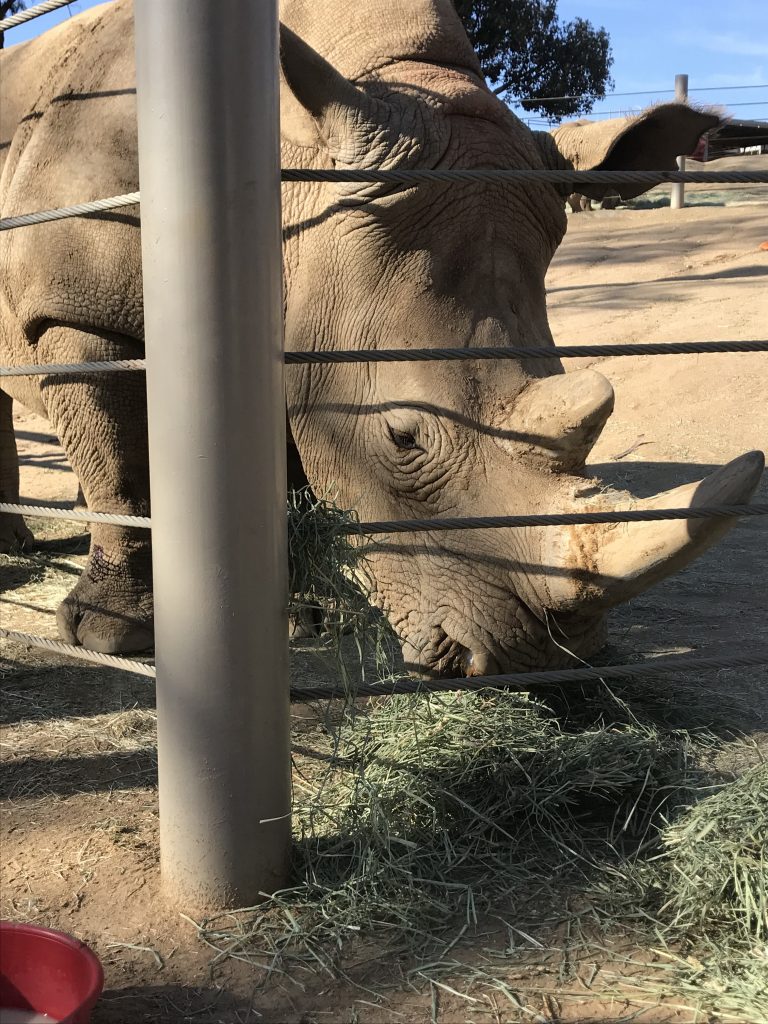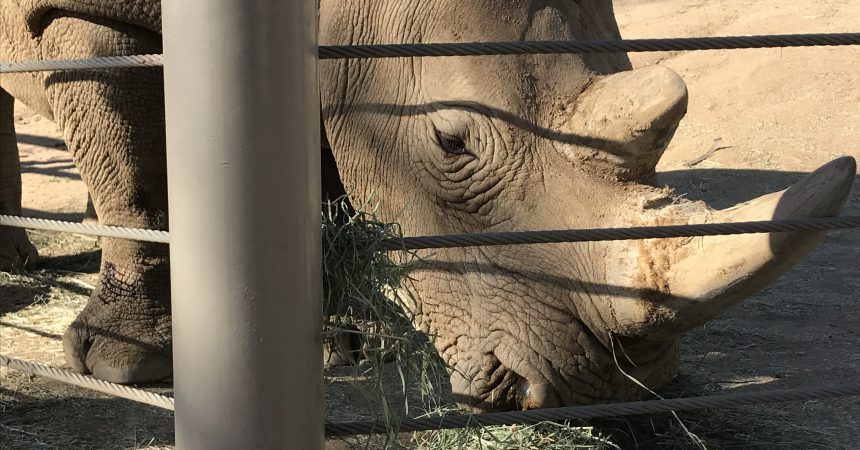Zoo InternQuest is a seven-week career exploration program for San Diego County high school juniors and seniors. Students have the unique opportunity to meet professionals working for the San Diego Zoo, Safari Park, and Institute for Conservation Research, learn about their jobs, and then blog about their experience online. Follow their adventures here on the Zoo’s website!
 The San Diego Zoo’s Rhino Rescue Center is dedicated to the conservation of northern white rhinos. However, it may surprise you that there are no northern white rhinos at the center. Instead, you will find six southern white rhinos, Amani, Victoria, Nakita, Hellene, Wallis, and Olivia. This is because there are only two northern white rhinos left in the world, a mother and daughter, that live at the Ol Pejeta Conservancy in Kenya. However, through the San Diego Zoo’s Rhino Rescue project, we might be able to save their species.
The San Diego Zoo’s Rhino Rescue Center is dedicated to the conservation of northern white rhinos. However, it may surprise you that there are no northern white rhinos at the center. Instead, you will find six southern white rhinos, Amani, Victoria, Nakita, Hellene, Wallis, and Olivia. This is because there are only two northern white rhinos left in the world, a mother and daughter, that live at the Ol Pejeta Conservancy in Kenya. However, through the San Diego Zoo’s Rhino Rescue project, we might be able to save their species.
On Thursday, we met with Senior Keeper, Jonnie Capiro. Ms. Capiro helps care for the six female southern white rhinos that live at the center. These southern white rhinos are crucial to the conservation of northern white rhinos because, eventually, the Zoo hopes to use these rhinos as surrogate mothers for northern white rhino babies. Working in conjunction with both the Reproductive Sciences and Genetics Team at the Institute for Conservation Research, keepers, like Ms. Capiro, are able to help with artificial inseminations, using southern white rhino sperm, to further develop and perfect reproductive technologies that are needed to perform in vitro fertilizations with northern white rhino embryos. After the processes have been perfected, the Zoo will implant a northern white rhino embryo using in vitro fertilization. This embryo will be created in the Reproductive Sciences lab using northern white rhino sperm and eggs that are currently being stored in the Zoo’s Frozen Zoo. However, that being said, the Zoo is still working to perfect artificial insemination in rhinos. When a female is ovulating, Ms. Capiro and her team will inseminate the female with a previously collected sperm sample. Given that artificial insemination is still a relatively new practice in rhinos, the Zoo is still decades away from trying in vitro fertilization with the precious northern white rhino samples. However, practicing artificial insemination of these rhinos allows the keepers and the reproduction scientists to perfect the tools and procedures that will be used for in vitro fertilization. This is important because there is a finite amount of northern white rhino DNA available to the Zoo’s scientists, so when the rhinos at the center are inseminated with northern white rhino embryos, there is very little room for error.
One way Ms. Capiro and the other southern white rhino keepers aid in this process is through training. In order for any of the reproductive team’s work to be done, keepers have to train the rhinos to undergo various medical procedures without the use of sedation. Among these are rectal ultrasounds that are administered once or twice a week in order to monitor current pregnancies, ovulation, and the rhino’s overall reproductive health. While a typical ultrasound is usually given over the skin, a rhino’s skin is so thick that it is nearly impossible to see anything if the ultrasound is done in a traditional manner. This is why Zoo researchers use specialized tools to examine the rhinos uterus from the interior of the intestinal tract. With an emphasis on positive reinforcement through treats, rhinos at the Rhino Rescue Center are trained to go inside shoot where the ultrasound is performed without the use of sedation.
In addition to ultrasounds, this process of training is used to artificially inseminate the rhinos. On paper this may seem pretty simple, but it is actually pretty tricky. Rather than simply inserting the sperm into the rhinos, the reproductive team has to navigate the rhino’s winding cervix in order to reach the rhino’s uterus. The team has developed various technologies in order to do so, such as scopes and flexible catheters. So far the team has had two successful pregnancies through artificial insemination, Amani and Victoria.
Before any of this can be done, the rhinos have to be healthy. This is where keepers come in once again. Ms. Capiro says that the keepers of these animals act as their advocates. Given that researchers rely on these animals for their studies, the keepers closely monitor the health of each individual rhino, and when they notice a change in behavior, they can notify the research teams immediately. Although it is very far down the road, with great teamwork between the rhino keepers and the researchers at the Institute for Conservation Research, the prospect of saving the northern white rhino is not so far out of reach.
Casey, Conservation Team
Week Four, Fall Session 2018


